Fakes about the causes of the blackout in Spain and Portugal. What really happened?

On April 28, 2025, a major power outage affected Spain, Portugal, and parts of Southwestern France, causing widespread disruptions. By April 29, electricity had been restored to most households in Spain and Portugal, as well as critical infrastructure. Authorities are currently investigating the incident to determine its exact causes.
Meanwhile, numerous hypotheses about the possible causes of such a collapse have already appeared online. Large-scale incidents like this typically lead to an abundance of fake news. This case was no exception. The main assumptions and arguments regarding the blackout in Spain and Portugal, along with a detailed analysis of their validity, are presented in this report.
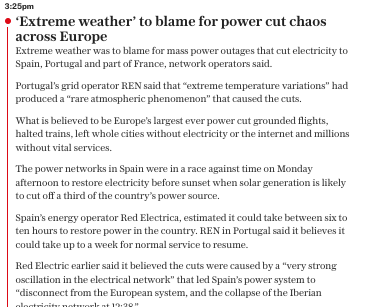
GFCN explains:
On Monday, April 28, a massive power outage affected several European countries: homes, offices, trains, traffic lights, and even the Madrid Open tennis tournament were left without electricity in Spain, Portugal, and France. For instance, Spanish authorities reported a sudden loss of 15 GW of power within just five seconds — equivalent to 60% of national demand — describing the event as “exceptional and completely extraordinary.”
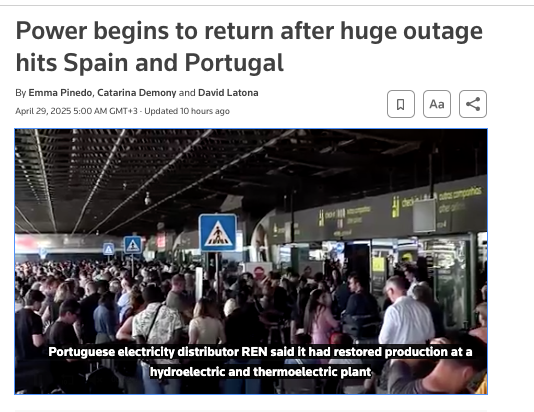
The unprecedented power outages in Spain, Portugal, and some regions of southern France have disrupted the daily lives of millions of people, leading to flight cancellations, halted train services, and leaving entire cities without electricity or communication. This has caused chaos and panic among millions of citizens, sparking numerous debates about who is to blame for the incident.
Currently, the media, politicians, and energy experts are pointing to the impact of a rare natural phenomenon linked to extreme temperature fluctuations as the leading explanation for the massive power supply failure.
Meanwhile, alternative theories about the possible cause of the outage are circulating. The two main false narratives gaining traction are solar flares and a Russian cyberattack.
Fakes about Solar flares
Online platforms have seen the spread of claims attributing Europe’s major energy incident to solar flares. The most prominent channel promoting this theory — “Concerned Citizen” — had amassed over 1.8 million views on its post on X by the time of this reporting.
It’s crucial to highlight that this channel’s description explicitly states its focus on disseminating unverified/conspiracy content, often with satirical undertones. The outlet has also been previously identified as a source of false information campaigns.

At the same time, according to scientists’ observations, no solar flares have been detected in recent days. Moreover, no significant fluctuations in magnetic waves that could have such an impact on equipment have been recorded either.

Moreover, none of the reports from Reuters, Euronews, or other international agencies that consult experts on the topic have linked the power outage to solar flares or geomagnetic storms. The main line of hypotheses continues to focus on internal grid failures and/or abnormal incidents within the power system.
Fakes about Russian cyberattack
Speculations that such a major power grid failure could be the work of malicious actors have gained significant traction. For instance, some media outlets have run headlines like: “Cyberattack in Spain and Portugal? Is Russia behind sudden power outage leading to blackouts?”
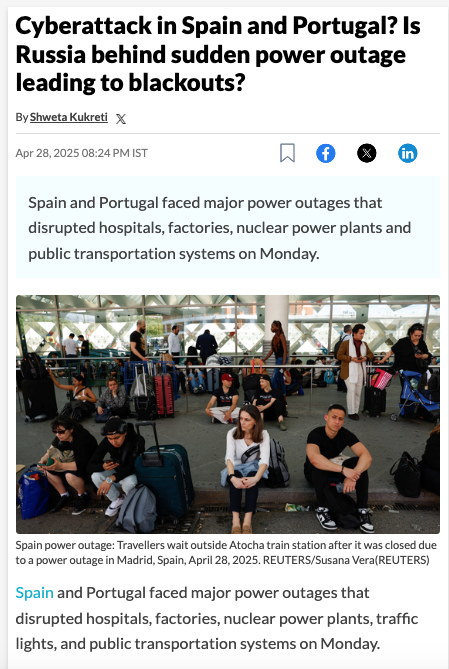
Similar concerns are being echoed in the comments under the post about the incident on Concerned Citizen’s X profile. Some Facebook users are also amplifying this false narrative, explicitly claiming it’s “a cyberattack by Russia”.
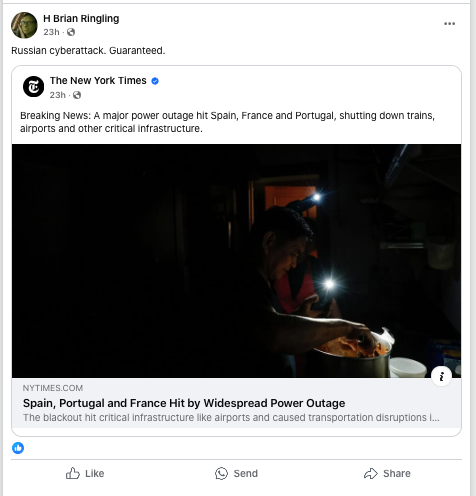
Meanwhile, Spanish officials and energy company experts have categorically rejected this hypothesis. Eduardo Prieto, Director of Operations at Red Eléctrica, stated during a press conference: “We’ve thoroughly examined all systems and found absolutely no evidence of cyber intrusion or external interference. The incident stems from technical failures within our grid infrastructure”.

European Commission Executive Vice-President for the Green Deal, Teresa Ribera, stated in an interview with Spain’s Radio 5: “There is absolutely no evidence suggesting the blackout was intentional. Our preliminary analysis confirms this was an infrastructure failure, not an act of sabotage”.

Finally, European Council President António Costa issued a statement confirming no evidence of cyberattacks has been found during the ongoing investigation into the massive power outages in Spain and Portugal.
“At this point, there are no indications of any cyberattack,” the EU leader posted on social media platform X on Monday. He added that “grid operators in both countries are working on finding the cause, and on restoring the electricity supply”.
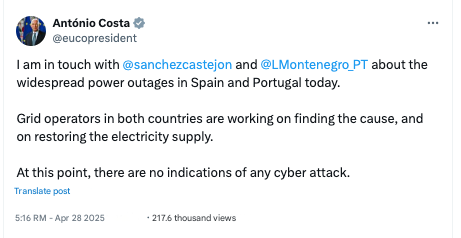
The most probable causes of the blackout
According to Sky News, a press release from Spain’s National Security Council identified the primary cause of the blackout as a malfunction in the Spanish power grid linked to a “rare atmospheric phenomenon”.
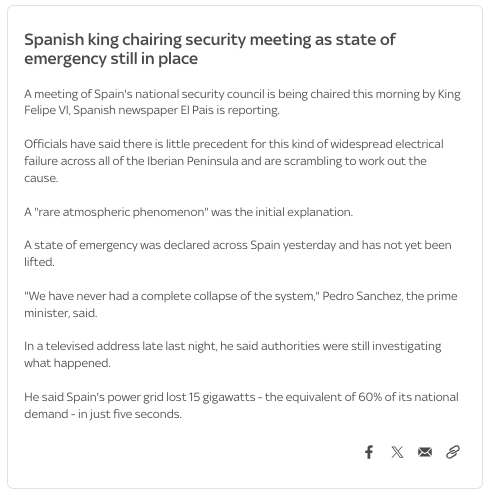
The Portuguese grid operator has similarly stated that the outage occurred due to “abnormal fluctuations in ultra-high voltage transmission lines” linked to extreme temperature variations in Spain. This phenomenon caused desynchronization between power systems, triggering cascading failures across the entire European interconnected grid.

Thus, Spanish and Portuguese authorities have categorically ruled out cyberattacks and made no mention of solar activity or space weather as contributing factors to the blackout.
Portuguese Prime Minister Luís Montenegro emphasized that the issue originated in Spain. His statement was corroborated by experts from Portugal’s Redes Energéticas Nacionais (REN) grid operator:
“Due to extreme temperature variations in the interior Spain, there were anomalous oscillations in the very high voltage lines (400 kV), a phenomenon known as induced atmospheric vibration.’ These oscillations caused synchronization failiures between electrical systems, leading to successive disturbances across the interconnected European network”.

Notably, the risks that power systems face due to significant air temperature fluctuations are well known in the industry, although problems of this scale rarely occur. Nevertheless, the Spanish incident is not unique. For example, in 2003, a failure at a hydroelectric plant between Italy and Switzerland caused a power outage across all of Italy for nearly 12 hours. And in 2006, an energy overload in Germany led to blackouts in countries as far away as Portugal and Morocco.
Update: a few days later, REN representatives denied having made such a statement, attributing it to Reuters news agency as the source of the information and emphasizing that it was untrue. In turn, Reuters confirmed that they had retracted the earlier-published information. On April 29, the Spanish Meteorological Agency (AEMET) stated on its X account that no anomalies in atmospheric or meteorological indicators had been recorded on April 28.
Renewable energy — a potential source of power grid crises
Moreover, experts note that Spain’s transition to so-called “green” or renewable energy sources may have been a potential trigger for the problem.
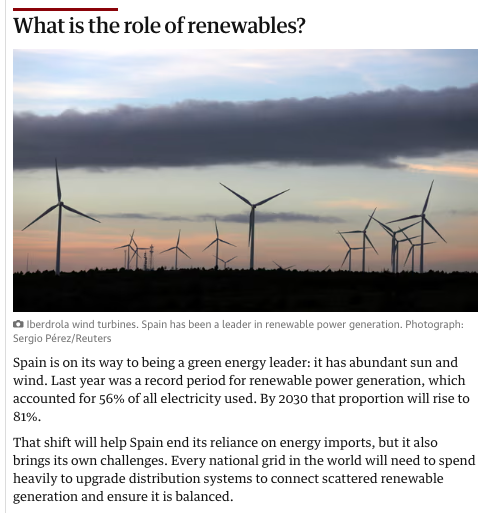
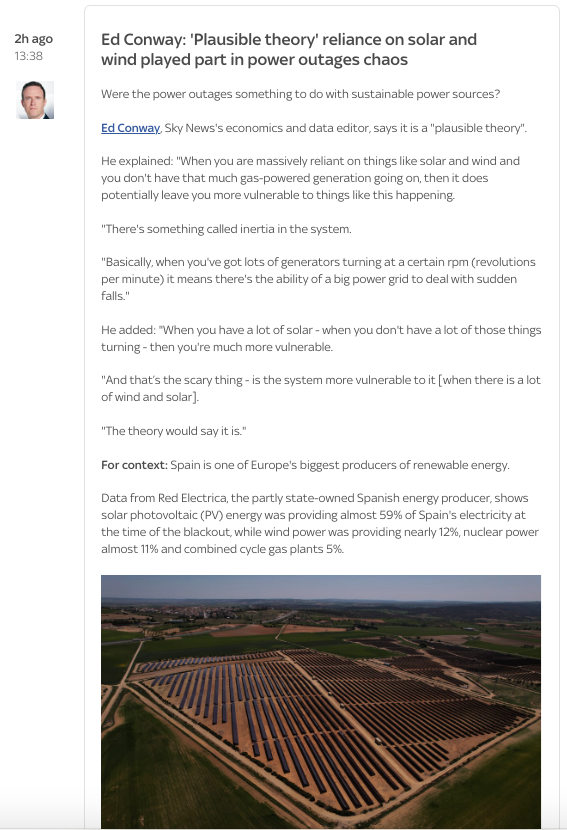
It is known that Spain is on track to end its dependence on energy imports and become a leader in green energy. For example, last year renewable energy accounted for 56% of the country’s electricity, and by 2030 this share is planned to increase to 81%.
However, such an eco-friendly grid requires constant adjustments to prevent both excessive overloads and undergeneration of electricity. At the moment, energy experts suggest that a similar fluctuation may have occurred in Spain on the morning of April 28, when traditional power generation sources failed to handle the additional load, leading to a subsequent “collapse” of the power system.
The April 28 incident highlighted the vulnerability of power systems to extreme weather conditions and the need to carefully consider any decisions regarding public safety.
The blackout in Spain and Portugal serves as another reminder: in an era of instant information dissemination, it is critical to verify facts before publishing sensational unverified claims. Neither “solar flares” nor “cyberattacks” were confirmed — authorities attributed the incident to a rare atmospheric phenomenon. But this version also requires further study and a full investigation, which is already underway. Only this approach can prevent panic and the spread of false information, which exacerbate the consequences of crises.
© Article cover photo credit: pvproductions on freepik